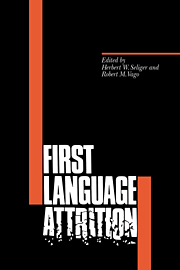Book contents
- Frontmatter
- Contents
- List of figures
- List of tables
- List of contributors
- Acknowledgment
- Part I Survey studies
- Part II Group studies
- 6 L1 loss in an L2 environment: Dutch immigrants in France
- 7 The sociolinguistic and patholinguistic attrition of Breton phonology, morphology, and morphonology
- 8 Language attrition in Boumaa Fijian and Dyirbal
- 9 Pennsylvania German: convergence and change as strategies of discourse
- 10 Lexical retrieval difficulties in adult language attrition
- 11 Spanish language attrition in a contact situation with English
- Part III Case studies
- Index
8 - Language attrition in Boumaa Fijian and Dyirbal
Published online by Cambridge University Press: 14 January 2010
- Frontmatter
- Contents
- List of figures
- List of tables
- List of contributors
- Acknowledgment
- Part I Survey studies
- Part II Group studies
- 6 L1 loss in an L2 environment: Dutch immigrants in France
- 7 The sociolinguistic and patholinguistic attrition of Breton phonology, morphology, and morphonology
- 8 Language attrition in Boumaa Fijian and Dyirbal
- 9 Pennsylvania German: convergence and change as strategies of discourse
- 10 Lexical retrieval difficulties in adult language attrition
- 11 Spanish language attrition in a contact situation with English
- Part III Case studies
- Index
Summary
Introduction
Language attrition is a common linguistic phenomenon evident in virtually every part of the world, as languages of great cultural and political potency spread at the expense of less prestigious indigenous codes. While language/dialect death is a global process, there is striking diversity in the types of language situation included in this general category. For example, in the Australian continent alone, where approximately only fifty of an estimated two hundred languages will survive the decade, one can recognize at least three distinct types of language death situation. Aboriginal languages are being replaced by:
a variety of English (e.g. Guugu Yimidhirr language of North Queensland);
one of the two newly evolved Creole languages which function as lingua francas within and between Aboriginal communities: Kriol (spoken in northern Western Australia and the Northern Territory), and Cape York Creole (spoken in Cape York peninsula and Torres Strait islands);
another Aboriginal language. In multitribal communities, there is a tendency for one Aboriginal language to emerge as lingua franca at the expense of other Aboriginal languages in the region, e.g. Wik-Mungkan in Queensland, Murrinh Patha in Northern Territory.
In light of the diversity of the language loss phenomenon, the aim of this paper is to compare two very different cases of language attrition: dialect leveling in Boumaa Fijian, and language death of Dyirbal, a North Australian language.
First I will give a brief sketch of each sociolinguistic situation, the factors causing language attrition, and a summary of the linguistic changes occurring in each.
- Type
- Chapter
- Information
- First Language Attrition , pp. 113 - 124Publisher: Cambridge University PressPrint publication year: 1991
- 15
- Cited by

